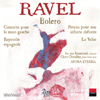Ravel Bolero
Ravel on period instruments brings results of striking clarity
View record and artist detailsRecord and Artist Details
Composer or Director: Maurice Ravel
Genre:
Orchestral
Label: Zig-Zag Territoires
Magazine Review Date: 10/2006
Media Format: CD or Download
Media Runtime: 72
Mastering:
Stereo
DDD
Catalogue Number: ZZT060901

Tracks:
| Composition | Artist Credit |
|---|---|
| Boléro |
Maurice Ravel, Composer
Anima Eterna Orchestra Jos van Immerseel, Conductor Maurice Ravel, Composer |
| Pavane pour une infante défunte |
Maurice Ravel, Composer
Anima Eterna Orchestra Jos van Immerseel, Conductor Maurice Ravel, Composer |
| Concerto for Piano (Left-Hand) and Orchestra |
Maurice Ravel, Composer
Anima Eterna Orchestra Claire Chevallier, Piano Jos van Immerseel, Conductor Maurice Ravel, Composer |
| Rapsodie espagnole |
Maurice Ravel, Composer
Anima Eterna Orchestra Jos van Immerseel, Conductor Maurice Ravel, Composer |
| (La) Valse |
Maurice Ravel, Composer
Anima Eterna Orchestra Jos van Immerseel, Conductor Maurice Ravel, Composer |
Author: Edward Greenfield
When Maurice Ravel’s orchestrations benefit so clearly from being played on modern instruments (see page 71), it may seem odd to have a disc of works on period instruments. In fact this well planned disc demonstrates very clearly what striking results can emerge, most of all in the work that most seriously runs the risk of being hackneyed, Boléro. Ravel himself regarded this as essentially an exercise in orchestration, with purely musical content minimised, and here what makes the performance so fascinating – much more compelling than usual – is the way that van Immerseel and his players bring out the contrasts between the different instruments.
The tendency has been in recent years for all woodwind instruments to sound similar in their smoothness, a process encouraged by Herbert von Karajan as a key influential figure. Here, with distinctive French-made instruments, the timbre of the different sections is sharply contrasted, giving a new and refreshing perspective to each contrasted instrumentation of the persistent tune. Also, the little portamento slides that Ravel marks in places for the brass sound even more natural than usual.
In short, it is the perfect showcase for period instruments from early in the 20th century. As an added point of authenticity, van Immerseel, using the composer’s own recordings, has researched very closely what speed Ravel wanted for a piece that is often taken too fast, here with pace nicely judged to allow the springing of rhythms so that in no way does it sound laboured. Similarly, the 1905 Erard piano used in the Left-Hand Concerto, with its rather clangy, clattering tone, gives extra clarity to the flourishes in the piano part. With Claire Chevallier a most sensitive soloist, very French in style, the piano is the more clearly defined over the highly original, generally low-lying orchestration, growling up from nowhere at the start. Also the Spanish flavours come out the more vividly in the later sections of this single-movement work, as of course they do in van Immmerseel’s reading of the Rapsodie espagnole.
The extra clarity is most refreshing, not least in the final item, La valse. If the choice of works might initially seem unadventurous or even arbitrary, in fact van Immerseel and his talented players consistently prove their point on the merits of Ravel on period instruments.
The tendency has been in recent years for all woodwind instruments to sound similar in their smoothness, a process encouraged by Herbert von Karajan as a key influential figure. Here, with distinctive French-made instruments, the timbre of the different sections is sharply contrasted, giving a new and refreshing perspective to each contrasted instrumentation of the persistent tune. Also, the little portamento slides that Ravel marks in places for the brass sound even more natural than usual.
In short, it is the perfect showcase for period instruments from early in the 20th century. As an added point of authenticity, van Immerseel, using the composer’s own recordings, has researched very closely what speed Ravel wanted for a piece that is often taken too fast, here with pace nicely judged to allow the springing of rhythms so that in no way does it sound laboured. Similarly, the 1905 Erard piano used in the Left-Hand Concerto, with its rather clangy, clattering tone, gives extra clarity to the flourishes in the piano part. With Claire Chevallier a most sensitive soloist, very French in style, the piano is the more clearly defined over the highly original, generally low-lying orchestration, growling up from nowhere at the start. Also the Spanish flavours come out the more vividly in the later sections of this single-movement work, as of course they do in van Immmerseel’s reading of the Rapsodie espagnole.
The extra clarity is most refreshing, not least in the final item, La valse. If the choice of works might initially seem unadventurous or even arbitrary, in fact van Immerseel and his talented players consistently prove their point on the merits of Ravel on period instruments.
Discover the world's largest classical music catalogue with Presto Music.

Gramophone Digital Club
- Digital Edition
- Digital Archive
- Reviews Database
- Full website access
From £8.75 / month
Subscribe
Gramophone Full Club
- Print Edition
- Digital Edition
- Digital Archive
- Reviews Database
- Full website access
From £11.00 / month
Subscribe
If you are a library, university or other organisation that would be interested in an institutional subscription to Gramophone please click here for further information.




